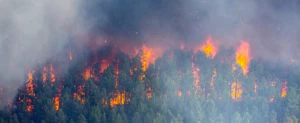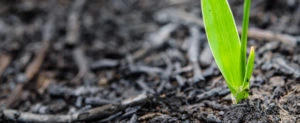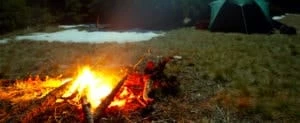Forest fires: the better you know them, the better you can prevent them
One year after the devastating fires in Fort McMurray, our thoughts go out to all Canadians who have been affected by this catastrophe, and everyone touched by natural disasters and extreme weather. Wether it's fire, floods or hail, the belairdirect teams are working tirelessly with our clients affected by these incidents, to help them get back on their feet.
The figure varies, but on average, more than 8,000 fires occur each year in Canada, burning over 2.3 million hectares across the country. While 45% of fires in the forest are caused by lightning, 55% of them are the consequence of human recklessness. With more education and prevention, we can bring this number down. Whether you’re an outdoor enthusiast or live close to a wooded area, you should always be vigilant—because forest fires have serious consequences.
Read on to learn about the triggers that can spark a forest fire and the surprising role of fire in the forest’s natural cycle. Finally, learn simple, effective tips to prevent fires and protect nature.
How does a forest fire get started?
A fire  develops when three elements come together: oxygen, fuel and heat. This is called the fire triangle. Oxygen is everywhere around us, wood is a common fuel and heat can be generated by lightning, an uncontrolled wild barbecue or a piece of glass under a ray of sunlight. The topography of the terrain is also a significant factor: if the fire develops at the bottom of a hill, it will take more quickly and the flames will spread faster. A forest under a summer sun with a bit of wind is therefore extremely susceptible terrain for fires. The hotter, drier and windier it is, the faster the flames will spread. The denser the forest, the more debris it contains, so the fire gets fed and grows more easily.
develops when three elements come together: oxygen, fuel and heat. This is called the fire triangle. Oxygen is everywhere around us, wood is a common fuel and heat can be generated by lightning, an uncontrolled wild barbecue or a piece of glass under a ray of sunlight. The topography of the terrain is also a significant factor: if the fire develops at the bottom of a hill, it will take more quickly and the flames will spread faster. A forest under a summer sun with a bit of wind is therefore extremely susceptible terrain for fires. The hotter, drier and windier it is, the faster the flames will spread. The denser the forest, the more debris it contains, so the fire gets fed and grows more easily.
More fires occur during dry periods and droughts because the vegetation is drier and more combustible. With added heat coming from outdoor activities like camping, campfires or barbecues, a lack of caution can lead quickly to fire. Heavy heat also sometimes leads to lightning.
Fires: an integral part of the forest cycle
As stra nge as it may seem, fires are part of the natural forest regeneration cycle. Long before people walked the earth, forest fires were common. Just like the animal kingdom, in the plant kingdom the fittest species survive, thereby ensuring strong, vigorous forests. Some trees, for example, can even regenerate after 80% of their surface has been scorched by flames. Even more surprisingly, some trees are “programmed” for forest fires. By burning, the trees release seeds that will sow the next generation of new growth. This is how a new life cycle begins.
nge as it may seem, fires are part of the natural forest regeneration cycle. Long before people walked the earth, forest fires were common. Just like the animal kingdom, in the plant kingdom the fittest species survive, thereby ensuring strong, vigorous forests. Some trees, for example, can even regenerate after 80% of their surface has been scorched by flames. Even more surprisingly, some trees are “programmed” for forest fires. By burning, the trees release seeds that will sow the next generation of new growth. This is how a new life cycle begins.
Of course, forest fires that occur too often are of no help to the forest, as some trees need more than 25 years to return to a mature stage. Nevertheless, nature continuously proves to be fascinating when you consider that phenomena as intense as forest fire turns out to be nature’s friend and helper.
You can never be too careful with fire
 People may be responsible for a large amount of forest fires, but they are also victims of them. Damage can be quite severe, both materially and physically, even if you’re not directly affected by the flames as the smoke and the heat released by a fire can cause serious problems. Some precautions must be taken to avoid such catastrophes.
People may be responsible for a large amount of forest fires, but they are also victims of them. Damage can be quite severe, both materially and physically, even if you’re not directly affected by the flames as the smoke and the heat released by a fire can cause serious problems. Some precautions must be taken to avoid such catastrophes.
Choose the tight time and place to build a fire Avoid making a fire when it's windy, as ashes could fly around and spark a fire. Clear a space of two metres around the area of your campfire, make sure the ground is as uniform as possible and keep the fire 15 metres away from houses or tents.
Pick up your glass bottles A ray of sunshine that passes through glass creates a magnifying effect, so when dry wood is nearby, fire can take quickly.
Beware of fireworks Do not light fireworks near a wooded area, and if it’s windy always keep a bucket of water nearby to pour on the residue.
Do not throw your cigarette into the wild The lit end of a cigarette butt thrown into a forest can have devastating consequences. If you smoke in the forest, take the time to completely extinguish your cigarette before getting rid of it.
Avoid burning your plant waste It’s important to remove debris from your yard so that it does not become combustible. Nevertheless, after cleaning your garden, bring your waste to composting or call for city pickup. If you burn it, with a little wind and trees nearby, your small fire could turn into a forest fire.
Protect your home from flames In hazardous areas, avoid planting bushes around your home and consider building a low wall.
To learn about best practices to prevent forest fires and keep protected from them, check out FireSmart online.
It’s the little, simple and effective acts that can change everything. Don’t hesitate to discuss fire prevention measures with your children so that in the event of danger, they are well prepared. With better education, prevention and a dose of caution, it’s possible to reduce the number of fires. Forest fires are everyone's business.

